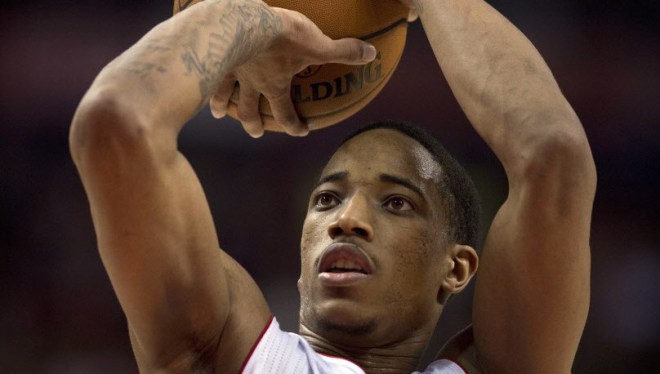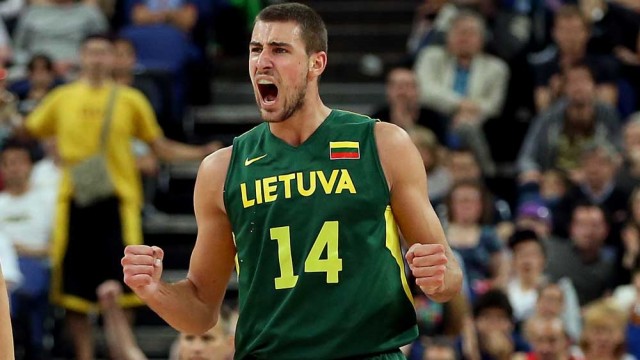A few weeks ago I wrote a shooting breakdown of the Raptors using the Nylon Calculus shooting charts. In the piece I was fairly critical of DeRozan’s high volume mid-range game.
I realized soon after the post hit the site that I sold DeRozan short by failing to bring a major part of his game into the discussion: free throw shooting.
A good 3-point shooter is sexier than Shakira’s gyrating hips in today’s analytics-driven game. In addition to the obvious fact that 3s count for more than 2s, good shooters also space the floor and open driving lanes to the basket. This is good and well but one important fact has been obfuscated by the love of the 3 ball: getting to the free throw line is actually more valuable than shooting a three. On this subject Andrew Johnson notes: “In the NBA last year, players made just under 36% of the 1766 three pointers taken, for an average of 1.078 points per three point attempt. Players made 75.6% of their free throw attempts for 1.51 points per shooting foul drawn on a two shot. And for those doing the math at home, yes 1.51 is greater than 1.078.”
This brings us back to DeRozan. While I still feel that his game would be well served by cutting down on long mid-range jumpers, part of the high volume, low efficiency critique waged against him is mitigated by the fact that DeRozan is among the league’s best at getting to foul line and making free throws. Last week Zarar offered up ways that DeRozan can improve driving to the basket and noted that DeRozan is 20th in the league in drives per game and 12th in points per drive. While DeRozan is likely too singularly focused on getting to the free throw line when he drives, his ability to get to the stripe nevertheless provides a hell of a lot of value to the team.
Last season DeRozan was 4th in the league in FTM per game behind only Love, Harden and Durant. He not only got to the line frequently, he also converted at an 82.4 % clip. Notably, DeRozan has improved at getting to the free throw line each year in the league. Last season he beat his previous career highs in free throw attempts and makes by 203 and 164, respectively. As you see below, DeRozan also got better at getting to the free throw line as the season went on:
| GP | FTM | FTA | FT% | |
|---|---|---|---|---|
| October | 1 | 0.0 | 2.0 | 0.0 |
| November | 14 | 5.0 | 6.1 | 81.4 |
| December | 14 | 5.2 | 6.7 | 77.7 |
| January | 15 | 6.5 | 8.3 | 78.4 |
| February | 12 | 7.8 | 9.2 | 85.5 |
| March | 16 | 8.1 | 9.3 | 86.6 |
| April | 7 | 7.9 | 9.1 | 85.9 |
He not only increased his attempts and makes per game, he also improved his percentages. By the time the playoffs rolled around, DeRozan was a veritable monster at the line. DeRozan led the playoffs in FTM per game by a wide margin at 10.1 makes per contest. Russell Westbrook was the next closest challenger at 7.6 FTM per game. Even more impressive, DeRozan improved his free throw shooting to 89.9% in the playoffs.
Another particularly impressive feature of DeRozan’s game is his ability to get to the line when it matters most. Per 82games.com, DeRozan was 5th best in the league at 18.5 free throw attempts per 48 minutes in clutch time last season. Clutch is defined here as any stat accumulated in the 4th quarter or overtime, with less than 5 minutes left, where neither team is ahead by more than 5 points.
Last season DeRozan was fouled on 16.4 % of his field goal attempts. In the clutch, however, DeRozan increased his already impressive rate of drawing fouls to 21.5%. This was a major jump from the 2012-2013 season where DeRozan was fouled on 13.7 % of his FGA and 14.6 % of his FGA in the clutch.
As a team the Raptors had the 7th-most FTA in the league last year. What’s significant there, aside from the high PPP value of getting to the line, is that teams across the league shot about a 5 percent lower eFG% after ‘stopped ball’ events such as made baskets, turn overs, fouls and time outs.
As we see, getting to the free throw line is valuable to a team in many ways. It’s not only a highly valuable shot in terms of points per possession. It also puts other teams into foul trouble and stops the ball, which enables teams to get back into their defensive sets and cuts down on fast break points allowed. Dean Oliver, author of Basketball on Paper and the first person to be hired as a full-time statistical analyst by an NBA team, determined that getting to the foul line frequently is one of the four most important keys for success in team basketball along with shooting a high eFG%, limiting turnovers and grabbing offensive rebounds.
DeRozan’s FG% this season was a less than desirable 43 percent. His true shooting percentage (53.2%) however, which takes into account two-point field goals, three-point field goals and free throws, was his highest since his rookie season and only a hair below the 53.89% league average. There are certainly downsides to DeRozan’s hyper focus on getting to the foul line such as taking bad shots in an effort to draw fouls and a tunnel vision which sometimes prevents DeRozan from finding open teammates and disrupts the flow of the game. Having said that, if we think about DeRozan’s offensive game holistically and take the time to appreciate the multi-faceted value of getting to the free throw line, we gain a more well-rounded understanding of what DeRozan brings to the Raptors.



